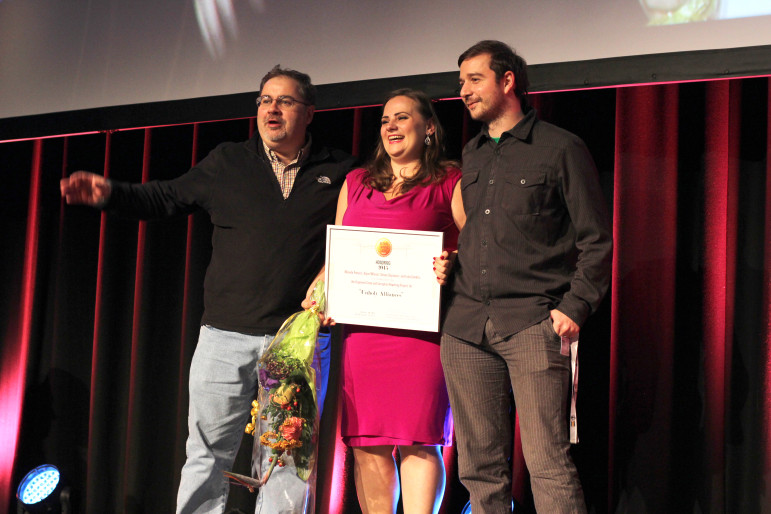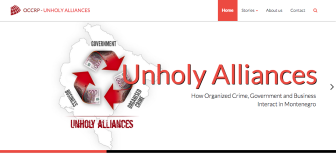

Innovate and Investigate: How OCCRP Gets the Story

“Unholy Alliances,” by the Organized Crime and Corruption Reporting Project, was a Global Shining Light winner in 2015. Photo: Kristine M. Gutterød.
Attending the recent Global Investigative Journalism Conference in Lillehammer – GIJC15 — demonstrated the incredible growth of cross-border reporting. Present were not only journalists from 121 countries, but also reporters from the largest newspapers like the New York Times to the smallest outlets like the four-person KRIK nonprofit in Belgrade. All were there talking about their stories and teaching the skills they’ve gained.
The Global Conference is where the changing nature of cross-border reporting has become most apparent. Most savvy media are on board the cross-border trend by now, at least in some small way, but judging from the discussions, journalists are getting more aggressive and expanding their scope. Highly visible were organizations like the International Consortium of Investigative Journalists (ICIJ) and Arab Reporters for Investigative Journalism (ARIJ), who were busy meeting with journalists from various media at large tables in the Lillehammer hotel dining room.
 Also active at GIJC15 was my own organization, the Organized Crime and Corruption Reporting Project (OCCRP), a consortium of 22 media organizations in Eastern Europe and Eurasia. OCCRP has always used the global conferences for building relationships – they have been invaluable for creating the kind of networks that can tackle the complex criminal networks we’ve gained recognition for exposing. When OCCRP started in 2006, getting a major media house to cooperate on a story was challenging. Now so many media approach the organization that it has to be selective. We’re grateful that OCCRP’s cross-border work has been honored with a string of major awards, including its fourth Global Shining Light at GIJC15, a European Press Prize earlier this year, and many others. Its consistency in producing high-profile projects has prompted a lot of questions about how we do our work. It’s not really that mysterious; The building blocks to OCCRP’s success were on open display in Lillehammer.
Also active at GIJC15 was my own organization, the Organized Crime and Corruption Reporting Project (OCCRP), a consortium of 22 media organizations in Eastern Europe and Eurasia. OCCRP has always used the global conferences for building relationships – they have been invaluable for creating the kind of networks that can tackle the complex criminal networks we’ve gained recognition for exposing. When OCCRP started in 2006, getting a major media house to cooperate on a story was challenging. Now so many media approach the organization that it has to be selective. We’re grateful that OCCRP’s cross-border work has been honored with a string of major awards, including its fourth Global Shining Light at GIJC15, a European Press Prize earlier this year, and many others. Its consistency in producing high-profile projects has prompted a lot of questions about how we do our work. It’s not really that mysterious; The building blocks to OCCRP’s success were on open display in Lillehammer.
First, in a globalized world, cross-border reporting really does work better. OCCRP relies on good journalists with extensive local knowledge to do stories better, cheaper, and faster. By offering back an international network of journalists to its members, we have been able to build deep and strong ties among reporters across a wide area of the world. Leveraging cross-border capacities and supplementing them with OCCRP’s teams of researchers, editors, artists, and programmers further maximizes that potential.
Conferences like those of GIJN have been instrumental in building up OCCRP and other journalism networks. It allows us to see who is good and to get to know them. The relationships that bind a number of OCCRP’s partners have been forged in such meetings. It also allows us to expand to media well beyond our borders and find partners around the world.
In many ways, OCCRP’s growth has mirrored the growth of GIJN and the cross-border journalism movement. ICIJ, another major cross-border organization, has also used these international meetings to recruit, so much so that there exists large overlaps between us, leading the two groups to cooperate on a number of projects.
OCCRP has benefited from a problem also on display in Lillehammer. The independent media in a number of countries are increasingly facing difficult times, with media closures, repressive laws, and arrests of journalists. Media in the developing world is increasingly controlled by political or criminal interests. The repression has indirectly helped investigative reporting – it has driven good reporters to the few nonprofits and independent media that have resisted the trend, and these groups tend to be OCCRP’s partners. OCCRP has been able to bring the best journalists from Europe to Asia together to work on projects by offering good stories, generous contracts, financial resources, training on safety and information security, and other resources that reporters really need. Fortunately, not all donors have forsaken these countries, which has allowed this important work to continue. The results are predictable: outrageous stories of crime and corruption done well. (And it helps win awards when your stories are really outrageous.)
OCCRP and its partners also have benefited from good timing: We were early adopters of using nonprofits and networked-based reporting. These models have proven resilient and are supported by donors who see them as having impact when other efforts are failing. OCCRP has grown up with these trends as we’ve striven to spread the practice of investigative journalism in the many countries where we operate.

OCCRP’s Khadija Ismayilova after winning the Global Shining Light Award in Rio, 2013. For her work, Khadija now sits in an Azerbaijan prison.
But OCCRP’s success can’t be explained merely by being in the right place with the right idea at the right time. The organization has done a good job setting a high standard in a part of the world where standards vary wildly; it has created a reporter-friendly environment that gets the best out of good reporters; it has built strong and deep ties based on trust with regional media and has been around long enough to prove that the model works; and it has benefited from visionaries like Paul Radu who are often one step in front of others. But had OCCRP not been on the edge of trends like cross-border collaboration, it might not be here today.
Going forward, we believe there is far more change ahead than there is behind. Smart media managers will need to allow for more waves of innovation that can propel or sink organizations.
And that, we think, will be the key: redefining the nature of investigative reporting which may lie more in the world of data science and Silicon Valley than in traditional project teams. News is more like a three-dimensional sphere, not a timeline. Rather than just reporting individual stories, we will be helping readers understand the topography of the political, business, or criminal worlds that influence them. This future is data rich and maximizes graphics, multimedia, and lots of creative interactivity.
Regardless of whether OCCRP can evolve into a content-rich technology company, we must get faster and more efficient at finding crime and corruption, and at quickly formatting that information into a user-friendly format.
To the extent that we have a secret, this is it: continuing to innovate and think out of the box, while integrating those ideas with the best practices of investigative journalism. Whether it’s the use of nonprofits and cross-border networks, or mapping the topography of entire criminal networks, it isn’t such a mystery.
Investigative reporting may look very different in two decades than it does now. We really are at the beginning of fundamental change. It promises to be a very interesting and challenging decade. Let’s see where we all get. See you at GIJC17 in Johannesburg.
 Drew Sullivan is a veteran journalist and media development specialist who has worked for a decade in Eastern Europe and Eurasia. He founded the Center for Investigative Reporting in Bosnia-Herzegovina and served as its director and editor. He co-founded the Organized Crime and Corruption Reporting Program, a regional consortium of investigative centers, where he is now advising editor.
Drew Sullivan is a veteran journalist and media development specialist who has worked for a decade in Eastern Europe and Eurasia. He founded the Center for Investigative Reporting in Bosnia-Herzegovina and served as its director and editor. He co-founded the Organized Crime and Corruption Reporting Program, a regional consortium of investigative centers, where he is now advising editor.









